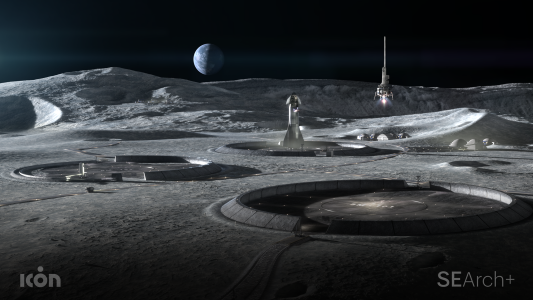
WHY THIS MATTERS IN BRIEF
While 3D printed buildings are disrupting how we build buildings on Earth off world it looks like it’s going to be the defacto standard.
 Interested in the Exponential Future? Join our XPotential Community, future proof yourself with courses from our XPotential Academy, connect, watch a keynote, or browse my blog.
Interested in the Exponential Future? Join our XPotential Community, future proof yourself with courses from our XPotential Academy, connect, watch a keynote, or browse my blog.
All around the world, with some notable exceptions like the UK, companies seem to be designing buildings using AI and 3D printing them cheaper and faster than ever before, from military barracks and government offices, to communities and homes. Now though Texas-based construction company ICON have announced they’ve been awarded a NASA contract to develop a 3D printed off-world construction system for, wait for it … the Moon.
Project Olympus will see ICON partner with architecture firms BIG and SEArch+ to design robust lunar structures that can be built using materials available on the Moon’s surface. As part of the program, ICON has also created a new division, dedicated to developing and demonstrating prototype elements for a full-scale space-based 3D printing system.
Through the project, NASA aims to develop a more sustainable presence on the Moon, and in doing so, allow humanity to become a permanently spacefaring civilization.
Courtesy: ICON
“Building humanity’s first home on another world will be the most ambitious construction project in human history and will push science, engineering, technology, and architecture to literal new heights,” said Jason Ballard, co-founder, and CEO of ICON.
“We are honored to begin our research and development on ICON’s Project Olympus and the Olympus Construction System.
ICON is a construction technologies firm that uses its proprietary 3D printing robotics, software, and advanced materials to build affordable homes around the world. The company recently gained $35 million in funding, and its current growth is reflected by that of other additive building businesses, such as Mighty Buildings and PERI over the last few months.
Working with partners such as the non-profit organization New Story, who recently printed an entire community in Mexico, ICON has been busy developing its technologies to 3D print more affordable housing for those in need.
Since then, the company has continued to expand the applications of its technology and worked with the US Marine Corps to print ‘vehicle hide structures’ at their Camp Pendleton base. Now, having earned a Small Business Innovation Research (SBIR) contract from NASA, ICON will gain additional funding to develop its technologies for use in outer space as well.
As part of its Artemis program, NASA is attempting to return astronauts to the Moon by 2024, and it has already used 3D printing to develop rocket engines and its lunar lander for the mission. Now, via its latest program named Project Olympus, the organization is aiming to create a method of printing enhanced lunar structures and to build a sustainable site for off-Earth exploration.
In order to establish a permanent lunar presence, the infrastructure will need to provide better thermal, radiation, and micrometeorite protection than is possible with current metal or inflatable habitats. That’s why NASA has turned to ICON, BIG, and SEArch+. By combining their expertise in construction and aerospace, the companies are attempting to design a new process for 3D printing structures, mainly using resources gained from the Moon’s surface.
During Project Olympus, ICON will work closely with NASA’s Marshall Space Flight Center to experiment with printing simulated lunar soil simulant using a variety of processing technologies. Building on the technique that it developed in 2018 for NASA’s Habitat Challenge, ICON ultimately aims to build a full-scale space 3D printer, which has already been nicknamed the ‘Olympus Construction System.’
According to Ballard, the advanced technology that will be developed during the project could also have significant applications on Earth as well. “I am confident that learning to build on other worlds will also provide the necessary breakthroughs to solve the housing challenges we face on this world,” said Ballard.
“Sometimes, for the biggest problems, it becomes necessary to look up at the sky and not only down at our feet. It would be hard to overstate how difficult this will be, but the ICON team is up for the journey and delighted to undertake this monumental task with NASA, BIG and SEArch+,” he added.
Although using additive manufacturing to build structures on the Moon may seem more sci-fi than reality, the concept has already been in development for a number of years.
In July 2019, the Russian space agency Roscosmos announced that it also plans to support long-term lunar missions by 3D printing structures made from on-site materials. According to Roscosmos Chief Dmitry Rogozin, Russian cosmonauts will land on the Moon for the first time in 2030.
China’s National Space Administration (CNSA) has also revealed plans to be the first country to establish a base on the Moon. The CNSA’s plans for a 3D printed structure were announced following the successful landing of the country’s Chang’e 4 module on the Moon in January 2019.
Elsewhere, the Technical University of Braunschweig and laser technology specialist Laser Zentrum Hannover e.V. (LZH), are also working to make moondust into a building material. In their research, the team suggested that a three kilos laser melting machine could be mounted to a rover, and transported to the Moon as a portable manufacturing system.






















[…] wants to do something to the Moon it seems – from building moonbases and 4G networks, to building nuclear reactors on its cratered surface. Now though there’s a […]